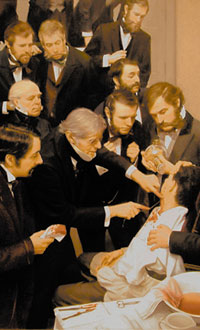When you first meet 4-year-old Roberto Salazar, you can't help but notice his unwavering smile and constant laughter. By all accounts, he's a very happy boy. World without pain is hell, parent says
By A. Chris Gajilan
Kids with rare disorder don't know they're hurting themselves
Four-year-old Roberto Salazar does not feel
pain because of a rare genetic disorder.It is only when he rams his head violently into walls or plays a little too roughly with a schoolmate, all the while smiling, that you are reminded that he suffers from an incredibly rare genetic disorder.
Roberto is one of 17 people in the United States with "congenital insensitivity to pain with anhidrosis," referred to as CIPA by the few people who know about it.
Roberto was born in July 2001, becoming Luis' and Juan's little brother. As a newborn, his parents thought he was the perfect baby.
"Roberto was wonderful. He never cried. He would sleep 23 out of 24 hours a day. He never cried to eat, never cried that his diaper is itching," said his mother, Susan Stingley-Salazar.
At 3 months, things abruptly changed. Roberto refused to eat. He was rapidly losing weight. His parents tried desperately to find ways to "force a child to eat that doesn't want to eat," Stingley-Salazar said.
First they tried to feed him with an eyedropper. Then a feeding tube was attached to his stomach at 8 months.
Other abnormalities quickly surfaced. Roberto was severely susceptible to heatstroke on hot summer days. His parents soon noticed he did not sweat.
"You can't carry Roberto because he sucks your heat from your body. You're hot, sweaty. His body can't sweat like yours so he's just absorbing all of your heat," Stingley-Salazar said.
His family was shocked when Roberto started teething. He gnawed on his own tongue, lips and fingers to the point of mutilation.
"If you could imagine when you bite your tongue how bad it hurts. At one point, you couldn't even distinguish that his tongue was his tongue," Stingley-Salazar said.
Stingley-Salazar, a registered nurse with a degree in molecular biology, took Roberto to see more than 60 physicians in the boy's first few years. She researched his symptoms on the Internet every night. She e-mailed any specialist she could find.
She came up with very few answers until she contacted Dr. Felicia Axelrod of the New York University Dysautonomia Treatment and Evaluation Center.
Axelrod has studied this family of "no-pain" diseases for more than 35 years. These genetic disorders affect the autonomic nervous system -- which controls blood pressure, heart rate, sweating, the sensory nerve system and the ability to feel pain and temperature.
Stingley-Salazar's first reaction: "There is somebody out there who actually knows what we've been going through, you know, the hell we've been living for the last two-and-a-half years."
CIPA is the most severe and fatal type of the seven types of hereditary sensory and autonomic neuropathy, or HSAN. Overheating kills more than half of all children with CIPA before age 3, Axelrod estimated.
According to Axelrod, levels of pain vary.
"For some children it's a mild degree such as breaking a leg, they'll get up and walk on the leg. They feel that something is uncomfortable but they keep on moving," she said. "For other children, the pain loss is so severe that they can injure themselves repetitively and actually mutilate themselves because they don't know when to stop."
All HSAN disorders are recessive genetic disorders -- both parents have to carry the genetic mutation in order to pass it on to a child. But there is less than a 1-in-4 chance that the child will develop it.
Neither of Roberto's older brothers has the disorder.
A more common HSAN condition is familial dysautonomia, or FD. There are about 500 cases of FD in the United States, Axelrod said.
The first sign of FD is a child's inability to suck properly followed by delayed milestones -- these children walk and speak later.
Often, FD patients endure severely dry eyes because they are unable to produce tears.
Also, part of this sensory disorder is difficulty "telling where they are in space," Axelrod said.
The minor effect is constantly bumping into things. The major effect is that 80 percent of these kids suffer curvature of the spine because they have no concept of posture.
"The hardest thing growing up with FD is that sometimes your balance can be off. Also when you get busy, like when your blood pressure drops, I faint. It's scary for people who don't know what to do," 15-year-old Perry Goldberger said.
Perry was diagnosed when she was 2 weeks old. She, too, suffers from common ailments of HSAN -- she gets liquids through a stomach tube; she can't distinguish between hot and cold; she doesn't feel pain.
Perry has learned to handle her daily medical regimen: During the day she takes nebulizer treatments for her lungs and seven tube feedings. At night she must use an oxygen machine to help her breathe and must place a moisture chamber around her eyes while she sleeps.
"This is my daily schedule that I take every single day. You get used to it after awhile," she said.
Her mother, Laurie Goldberger, said her family takes it one day at a time and is teaching Perry a certain level of independence.
"Now at 15, she's gotten very responsible and understands it and she knows she has to take it. So at school she does her own medicine," Goldberger said.
Axelrod points to Perry as an example of the huge strides made in HSAN disorders.
"Forty years ago, a child with FD had a 50 percent probability of reaching the age of 5," she said. "Today, a child born with FD would have a 50 percent probability of reaching the age of 40."
Refs
HOME
Resources
Snapshots
Anaesthesia
Life without pain

